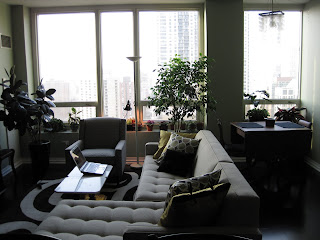Behold! My Stapelia flavopurpurea in all of its stocky, spotted glory! To really appreciate what makes this guy special you have to see it in bloom. Little spindly yellow-red star fish perched upon the tips of each arm giving off a delicate, sweet fragrance. Stay tuned for pictures of the flowers, but that won't happen until late Summer, early Fall, if at all (given my less than optimal lighting situation). The blooming habits of this little guy are even more special if you consider that the other members of its family have flowers that smell of rotting meat. Oh, yes. It is true and I have PROOF!
So, the subfamily Asclepiadoideae includes some great examples of the creative lengths to which plants have evolved in inhospitable climates. The subtropical arid climates in which these stinky succulents are endemic lends itself to an abundance of flies, but a paucity of bees and birds to assist in pollination. Rather than competing for the attention of the latter, the Hoodia, Stapelia, and Huernia spp. have evolved to attract flies to pollinate their flowers! By creating flowers that stink of death and decay, and even in some cases resembling open wounds and mimicking the textures of rotting, moldy meat, these smelly succulents have the blow fly market cornered! Outstanding!
This is one of the reasons S. flavopurpurea is so interesting. A stapeliad that doesn't stink! Very special. I sure hope mine blooms eventually or at least gets some new growth on it this summer.
Stapelia scitula, on the other hand, is blooming like crazy. Well, I won't go that far, but it is covered in buds and has one or two flowers at a time that last about a full week each. Supposedly this plant blooms throughout the year and sometimes quite impressively. I personally love plants that bloom frequently. It can get rather boring waiting for that once a year treat, so having a few regular bloomers around the house really help to cheer up those drab Chicago winter days. These guys do stink, but with each bloom the size of a nickel, you really have to get your nose up into the flower to smell it. Dirty socks. Weird.
This Arid Lands/Gethsemane find (I am embarrassed to say) may have been purchased before one was technically supposed to do so...(oops). It was two weeks before the scheduled open house, and after searching online nurseries for a S. scitula, LOW AND BEHOLD Gethsemane gardens has at least half-a-dozen of them! There may have been a sign over the shelf that said "Not for sale yet," but I didn't realize this until AFTER I had already paid at the desk for it. Well, karma came my way and part of a small branch got knocked off in transit (see photo from last post), but the plant itself has doubled in size since then and now seems to be as happy as a clam! Of course I let the stem dry out for a few days before sticking it in some soil. Maybe it will root! Mea culpa.





